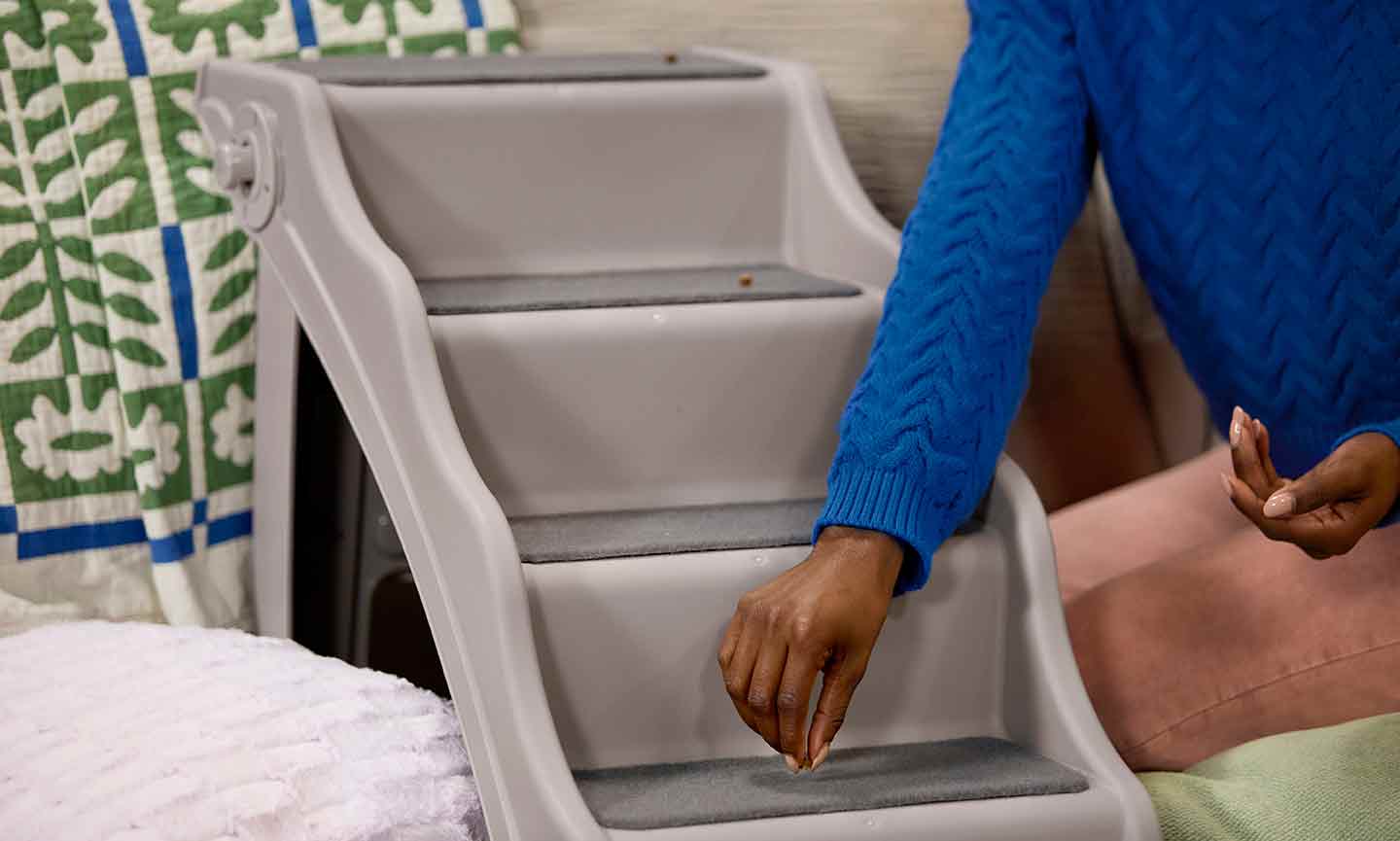You love snuggling with your dog on the couch and falling asleep together in bed at night. But jumping up to join you on those high surfaces might be a challenge for your dog if they’re small, easing into their senior years or are just a little afraid to take the leap. With a set of stairs, your pet can confidently get on and off of your couch, bed and other high places—and spend more time snuggling with you.
Read on for dog training tips for teaching your pooch to use pet stairs, whether they are a senior dog, a small breed or a new puppy.
How to Train a Dog to Use Dog Stairs: Step-by-Step Instructions
Before you get started, remember that climbing stairs and going down the stairs repeatedly is hard on the body, especially for puppies and older dogs. So no matter whether your dog is a puppy, a senior or somewhere in between, keep your training sessions short, no more than 5 minutes at a time. Most dogs learn this skill in a few sessions, but it can take a bit longer with a new puppy or fearful dog.
Follow these dog training steps for teaching your dog to go up and down stairs.
1 Gather Your Supplies
Here’s what you’ll need:
- A set of pet stairs
- Dog treats, cut up very tiny
- Cushions or pillows to put around the stairs (for safety)
When choosing a set of stairs, consider the following:
- How high does the dog need to reach? Your stairs should be about as tall as the sofa seat or bed where your dog wants to go.
- What’s the stair surface like? Wood and metal are slippery, which can lead to potentially dangerous falls from the stairs. Look for rubber or carpet instead.
- How tall and deep is each step? Pick something suitable for your dog’s size. Most pet stairs come with a recommended size range for dogs, so check the product details before you purchase.
2 Pick the Right Location for the Steps
Set the steps up next to a piece of furniture like your bed or couch, giving your dog a straight, clear pathway to the top. It might be extra-motivating for your dog if you start by placing the steps next to a location they especially love, like your typical cuddle spot.
To keep your dog safe, put couch cushions or pillows on both sides of the pet stairs, so the dog has a soft landing if they slip. Those cushions don’t have to remain there forever—you can remove them once your dog is comfortable and adept at navigating the stairs.
3Put Treats on the Steps
4Reinforce Your Dog’s Efforts to Climb the Steps
As your pup sniffs the dog treats, they may naturally place a paw on the stairs. If this happens, praise and put extra treats on the step.
If your dog hesitates to touch the stairs, hold a treat in your hand in front of your dog’s nose, and slowly move it to the tread of the step above the dog. If your dog doesn’t follow the treat closely (i.e. if their nose doesn’t stay at least two inches from the treat in your hand), start over. Move the treat back to their nose, and try to lure them toward the stairs again.
If your dog still hesitates, you have a couple of options:
- Try a different treat—an extra-smelly, super-tasty, beyond-enticing treat, that is!
- Scatter more dog treats on the steps and then step away. Let your dog explore and watch to see what they do next. When they step onto the stairs, praise and then try luring them with a treat again.
Repeat this process to get your dog onto the second step, then the next step, and so on.
5Reward Your Dog Even More When They Reach the Top
6Do It in Reverse
To teach your dog to go down stairs, repeat steps 2-4 in reverse. Start with your dog on the furniture near the top of the stairs. Place dog treats on the stairs and praise and treat for each step they go down. Have a fun hangout session when they reach the bottom of the stairs.
Training a dog to go down stairs sometimes takes longer than training them to go up. Going down the stairs is awkward when you have four paws—imagine going down the stairs on your hands and knees! Remember to practice extra patience with your pup during this step.
You may need to do several training sessions before your dog starts walking up and down the stairs on their own. Praise, pet, and feed a bonus treat when they do. Soon they’ll be climbing stairs like a champ!
What If My Dog Still Won’t Use the Steps?
Try these troubleshooting tips if your dog just isn’t getting on board with using the stairs:
- If your dog is hesitant, take things extra-slow. Keep training sessions super-short (think 30 seconds) and feed plenty of treats even if they don’t make much progress.
- If your dog doesn’t want to get near the stairs, leave them in place for a few days. Most dogs adjust to new objects in time. Once your dog seems comfortable, try the training again, remembering to take it slow.
- Some dogs find stairs physically challenging. Consider using a dog ramp instead, so your dog doesn’t have to lift their feet as high. You can use the same steps above to teach your dog to use a pet ramp.
- If you’re struggling, consult a certified trainer or dog behavior consultant. Look for professionals with a CBCC-KA or a CDBC certification—you can find one near you using the Certified Dog Trainer and Behavior Consultant Directory.
Pet stairs are a great way to expand a dog’s world. Train them to use them on their own, and they’ll be able to come hang out with you more often, too.
What’s next on your training journey with your dog? Find even more new skills your dog can learn.
More Dog Training Tips
Share:



























